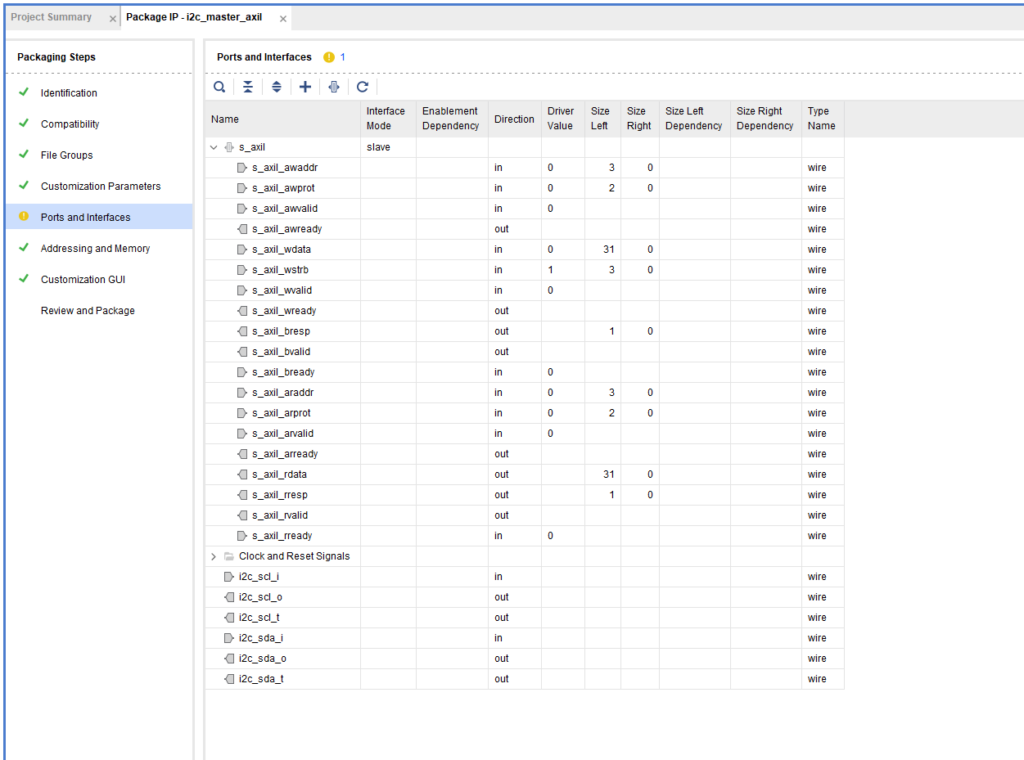

Vivado 打包开源IP核并验证 (I2C外设)
source link: https://www.taterli.com/9711/
Go to the source link to view the article. You can view the picture content, updated content and better typesetting reading experience. If the link is broken, please click the button below to view the snapshot at that time.

Vivado 打包开源IP核并验证 (I2C外设)
Vivado 打包开源IP核并验证 (I2C外设)
有时候下载别人写好的RTL IP,每次挨个连线AXI总线也挺麻烦的,而且也不直观,打包起来再用就方便多了嘛.
我这里打包的是alexforencich大佬写的I2C核,具体地址大家观摩.
https://github.com/alexforencich/verilog-i2c
新建工程并包含主要AXI所用到的三个文件.

菜单Tools->Create and Package New IP,选择Package your current project.

选好一个目录开始打包.

之后就会直接进入IP编辑,其他信息大家自己都明白自己填写了,其中端口是我们最关心的,可以看出他已经自动整理好了,如果我们要编辑某些接口使用条件或者参数,也是可以继续编辑的.

如果为了规范发布,也应该完善其他选项,比如Addressing and Memory把寄存器都填好,方便其他人嘛,还要注意RST的属性是高复位的,然后我就直接打包了.

加到我的bd里,另一个我则是以Add Module形式,自己添加了一个RTL文件,这样适配输出inout口.

接下来还要规划一下地址分布,我这里仅仅测试一下就保持默认了.

具体寄存器分布查看i2c_master_axil.v文件就知道,大佬都把注释写的非常好,
/******************************************************************************
* Copyright (C) 2023 Advanced Micro Devices, Inc. All Rights Reserved.
* SPDX-License-Identifier: MIT
******************************************************************************/
/*
* helloworld.c: simple test application
*
* This application configures UART 16550 to baud rate 9600.
* PS7 UART (Zynq) is not initialized by this application, since
* bootrom/bsp configures it to baud rate 115200
*
* ------------------------------------------------
* | UART TYPE BAUD RATE |
* ------------------------------------------------
* uartns550 9600
* uartlite Configurable only in HW design
* ps7_uart 115200 (configured by bootrom/bsp)
*/
#include <stdio.h>
#include "platform.h"
#include "xil_printf.h"
#include "xparameters.h"
#define I2C_STATUS (XPAR_I2C_MASTER_AXIL_0_BASEADDR + 0x00)
#define I2C_COMMAND (XPAR_I2C_MASTER_AXIL_0_BASEADDR + 0x04)
#define I2C_DATA (XPAR_I2C_MASTER_AXIL_0_BASEADDR + 0x08)
#define I2C_PRESCALE (XPAR_I2C_MASTER_AXIL_0_BASEADDR + 0x0C)
#define CMD_START (1<<8)
#define CMD_READ (1<<9)
#define CMD_WRITE (1<<10)
#define CMD_WR_M (1<<11)
#define CMD_STOP (1<<12)
int main()
{
uint32_t Reg;
init_platform();
*((uint32_t volatile *)(I2C_PRESCALE)) = 150;
Reg = *((uint32_t volatile *)(I2C_PRESCALE));
*((uint32_t volatile *)(I2C_COMMAND)) = CMD_START | CMD_WR_M | 0xA0;
*((uint32_t volatile *)(I2C_DATA)) = 0x0105;
*((uint32_t volatile *)(I2C_DATA)) = 0x0310;
*((uint32_t volatile *)(I2C_COMMAND)) = CMD_STOP | 0x50;
print("Hello World\n\r");
print("Successfully ran Hello World application");
cleanup_platform();
return 0;
}
Recommend
About Joyk
Aggregate valuable and interesting links.
Joyk means Joy of geeK